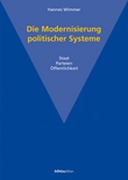Explore

Die Modernisierung politischer Systeme
Hannes Wimmer
2000
Neben einem Überblick über die Modernisierungsprobleme von Entwicklungsländern untersucht der Autor den Konstitutionsprozeß des modernen Staates in Europa. Welche sind die zentralen "Institutionen des Staates"? In welcher Weise ist die Ausdifferenzierung der politischen Parteien an die ideologischen Strömungen der politischen Öffentlichkeit geknüpft, und sind es im wesentlichen die Prozesse der medialen Kommunikationsrevolutionen, welche die Sinnstiftungsmärkte der Gegenwart völlig verändern und damit u. a. die Parteien zu erheblichen Anpassungen zwingen? Die Zukunft der Demokratie, so der Schluß des Autors, hängt daher in hohem Maße von der Operationsweise der Subsysteme und ihren Interaktionseffekten ab
This book is included in DOAB.
Why read this book? Have your say.
You must be logged in to comment.
Rights Information
Are you the author or publisher of this work? If so, you can claim it as yours by registering as an Unglue.it rights holder.Downloads
- 110 - pdf (CC BY-NC-ND) at OAPEN Library.
- 243 - pdf (CC BY-NC-ND) at OAPEN Library.
- 231 - pdf (CC BY-NC-ND) at OAPEN Library.
Keywords
- Comparative government
- History
- Humanities
- institutions of consolidated modern statehood
- Modernisierungsprobleme von Entwicklungsländern
- Modernisierungsprobleme von Entwicklungsländern, Parteien
- Neopatrimonialism
- origins and development of the modern state in European history
- Parteien
- Politisches System
- subsystems of democracy
- The State
- thema EDItEUR::N History and Archaeology::NH History
- theory of the state
Links
DOI: 10.26530/oapen_472490Editions

